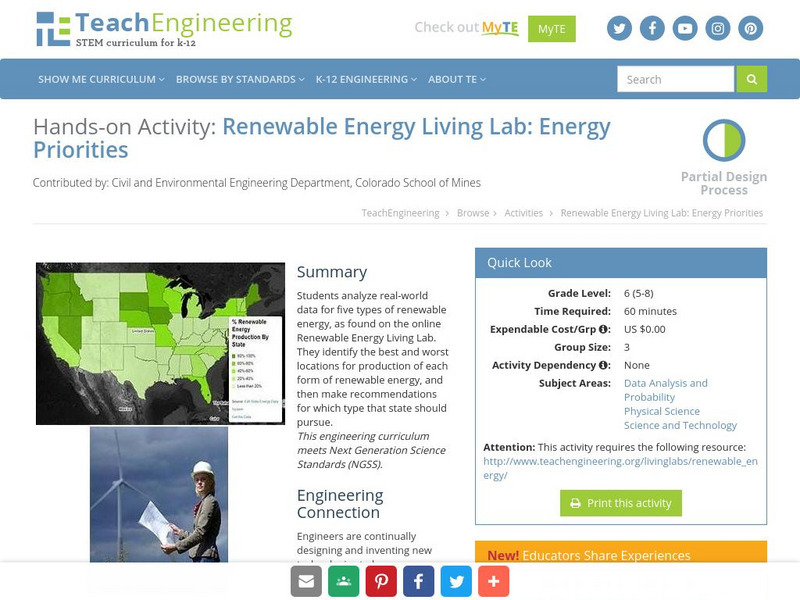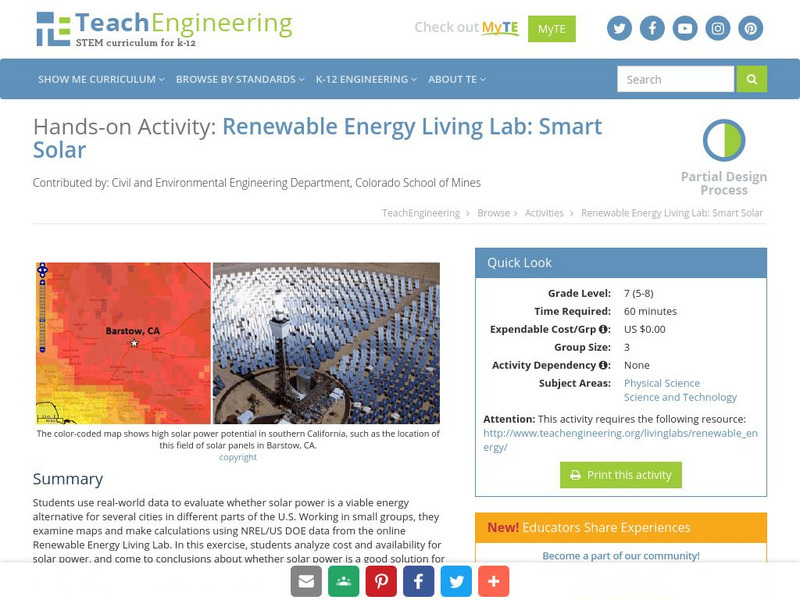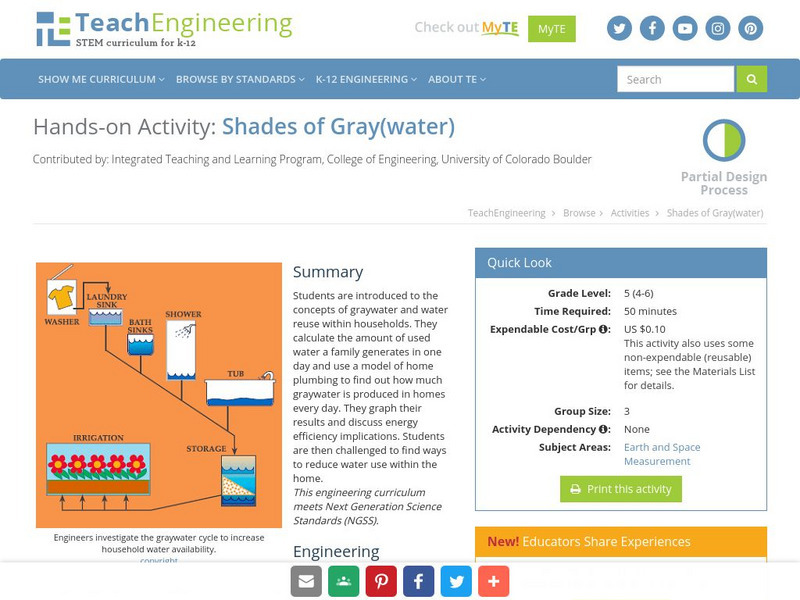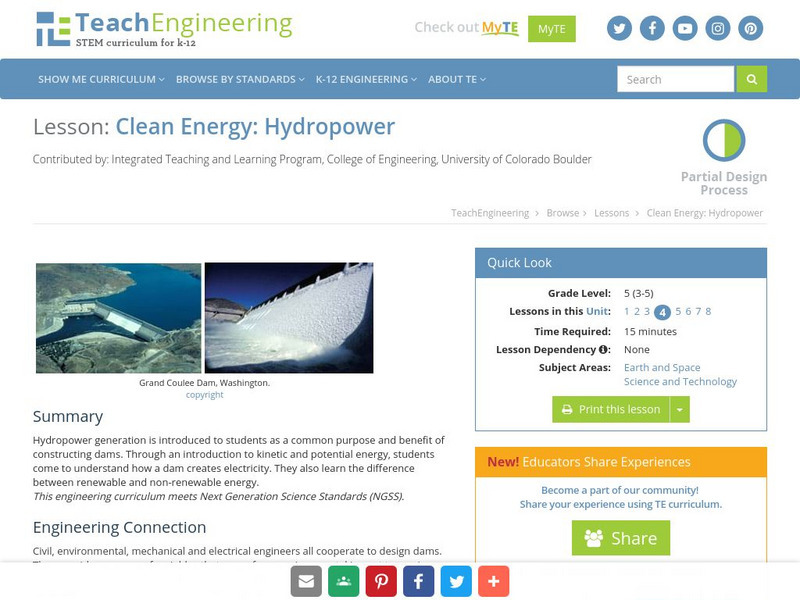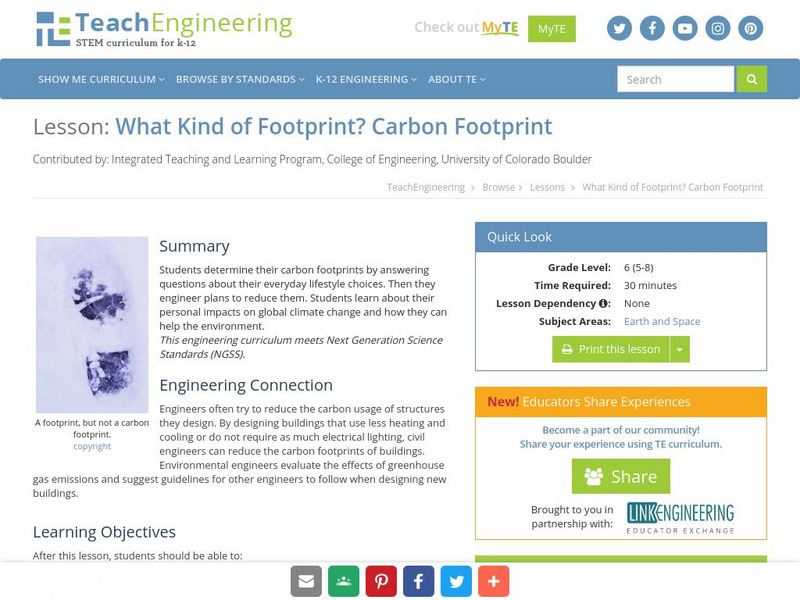TeachEngineering
Teach Engineering: Household Energy Audit
Students review the electrical appliances used at home and estimate the energy used for each. The results can help to show the energy hogs that could benefit from conservation or improved efficiency.
TeachEngineering
Teach Engineering: Renewable Energy Living Lab: The Bright Idea
Students use real-world data to evaluate the feasibility of solar energy and other renewable energy sources in different U.S. locations. Working in small groups, students act as engineers evaluating the suitability of installing solar...
TeachEngineering
Teach Engineering: Renewable Energy Living Lab: Energy Experts
Students use real-world data to evaluate various renewable energy sources and the feasibility of implementing these sources. Working in small groups, students use data from the Renewable Energy Living Lab to describe and understand the...
TeachEngineering
Teach Engineering: Renewable Energy Living Lab: Energy Priorities
Students analyze real-world data for five types of renewable energy, as found on the online Renewable Energy Living Lab. They identify the best and worst locations for production of each form of renewable energy, and then make...
TeachEngineering
Teach Engineering: Renewable Energy Living Lab: Power Your School
Students use real-world data to calculate the potential for solar and wind energy generation at their school location. After examining maps and analyzing data from the online Renewable Energy Living Lab, they write recommendations as to...
TeachEngineering
Teach Engineering: Renewable Energy Living Lab
Students become familiar with the online Renewable Energy Living Lab interface and access its real-world solar energy data to evaluate the potential for solar generation in various U.S. locations. They become familiar with where the most...
TeachEngineering
Teach Engineering: Renewable Energy Living Lab: Smart Solar
Students use real-world data to evaluate whether solar power is a viable energy alternative for several cities in different parts of the U.S. Working in small groups, they examine maps and make calculations using NREL/US DOE data from...
TeachEngineering
Teach Engineering: Breathing Cells
Students use a simple pH indicator to measure how much CO2 is produced during respiration, at rest and after exercising. They begin by comparing some common household solutions in order to determine the color change of the indicator....
TeachEngineering
Teach Engineering: Shades of Gray(water)
Students are introduced to the concepts of graywater and water reuse within households. They calculate the amount of used water a family generates in one day and use a model of home plumbing to find out how much graywater is produced in...
TeachEngineering
Teach Engineering: Energy Efficient Housing
We all know that it takes energy to provide us with the basics of shelter: heating, cooling, lighting, electricity, sanitation and cooking. To create energy-efficient housing that is practical for people to use every day requires...
TeachEngineering
Teach Engineering: Environmental Engineering and Water Chemistry
Students are introduced to the fundamentals of environmental engineering as well as the global air, land and water quality concerns facing today's environmental engineers. After a lesson and activity to introduce environmental...
TeachEngineering
Teach Engineering: Introduction to Environmental Challenges in China
Through an overview of some of the environmental challenges facing the growing and evolving country of China today, students learn about the effects of indoor and outdoor air pollution that China is struggling to curb with the help of...
TeachEngineering
Teach Engineering: Clean Energy: Hydropower
Hydropower generation is introduced to students as a common purpose and benefit of constructing dams. Through an introduction to kinetic and potential energy, students come to understand how a dam creates electricity. They also learn the...
TeachEngineering
Teach Engineering: Dam Impacts
While the creation of a dam provides many benefits, it can have negative impacts on local ecosystems. Learners learn about the major environmental impacts of dams and the engineering solutions used to address them.
TeachEngineering
Teach Engineering: Clean It Up!
Students learn about a special branch of engineering called bioremediation, which is the use of living organisms to aid in the clean-up of pollutant spills. Students learn all about bioremediation and see examples of its importance. In...
TeachEngineering
Teach Engineering: What Kind of Footprint? Carbon Footprint
Young scholars determine their carbon footprints by answering questions about their everyday lifestyle choices. Then they engineer plans to reduce them. Students learn about their personal impacts on global climate change and how they...
TeachEngineering
Teach Engineering: Biological Processes: Putting Microbes to Work
Students learn the fundamentals of using microbes to treat wastewater. They discover how wastewater is generated and its primary constituents. Microbial metabolism, enzymes and bioreactors are explored to fully understand the primary...
Arizona State University
Arizona State University: Water Survivor Class
Lesson addresses the challenge of supplying clean water during times of a shortage and includes a look at the various water-treatment and filtration processes in place to insure a safe water supply.
Encyclopedia of Earth
Encyclopedia of Earth: Bioremediation
Explains what bioremediation is, how it works, whether it is a safe process, the length of time it takes, and reasons for doing it. (Updated: September 23, 2011)
Cosmo Learning
Cosmo Learning: Fundamentals of Environmental Pollution and Control
A collection of video lectures from a fundamentals of environmental pollution and control course taught at the National Programme on Technology Enhanced Learning. The course teaches water pollutants, waste water treatment, soil acidity,...
Cosmo Learning
Cosmo Learning: Water Resources Engineering
A collection of video lectures from a course on water resources engineering. Webpage includes twenty-eight lectures from a professor at the National Programme on Technology Enhanced Learning. Lectures vary in length and cover topics like...





